Japan
Wood Products Prices
Dollar Exchange Rates of 25th
January
2018
Japan Yen 111.26
Reports From Japan
Boost in private sector
spending a surprise
Private-sector machinery orders rose in November, the
second monthly gain, driven mainly by orders from
service sector providers (see graphs right).
While this gain came as a surprise (analysts forecast a
decline) the positive numbers add to the sense that the
Japanese economy is really picking up. In view of the
positive news the Japanese Cabinet Office maintained its
forecast for private sector capital spending to continue to
increase. However, on a cautionary note, analysts point out
that machinery orders by manufacturers declined.
Japanese firms are slowly investing in equipment to boost
capacity and in automation to address a labour shortage
which is expected to become worse as the population of
working age people shrinks.

US shutdown drives dollar lower
Worries the US government shutdown weighed heavily on
the yen/dollar exchange rate. At one point late in the
month the US dollar was at a three-year low marking five
weeks of declines.
The stop-gap US legislation to fund essential US
government services until mid-February stemmed the
dollar fall.
On the 25 January the dollar was at a high of around yen
109 but since gave up some strength. However, analysts
are constantly watching for any change in the stance of the
Bank of Japan where there are suggestions that it could
begin to pull out from its aggressive monetary easing
policy, a move which would see the yen strengthen.

New report on Japan¡¯s housing demand
Satprnews, a company in the EU, has announced the
release of a report ¡®Single-Family Housing Construction in
Japan to 2020: Market Databook¡¯ this, says the Satprnews
website, contains detailed historic and forecast market
value data for the single-family housing construction
industry, including a breakdown of the data by
construction activity (new construction, repair and
maintenance, refurbishment and demolition).
Satprnews writes ¡±the report provides a top-level overview
and detailed insight into the operating environment of the
single-family housing construction industry in Japan. It is
an essential tool for companies active across the Japanese
construction value chain and for new players considering
to enter the market.¡±
See: http://www.satprnews.com/2018/01/16/single-familyhousing-
construction-in-japan-to-2020-market-databookconstruction-
manufacturing-and-construction-residentialconstruction-
industries/
Housing data from Japan¡¯s Ministry of Land,
Infrastructure, Transport and Tourism show that December
2017 starts were down year on year, the sixth straight year
on year drop.
Annual housing starts for 2017 came in at almost the same
level as in 2016.

Import round up
Doors
Despite the surprise jump in November wood door imports
into Japan, total 2017 imports are set to be below those of
a year earlier.
November 2017 imports of wood doors (HS441820) were
up sharply year on year (+19%) and compered to levels in
October a 17% rise was observed.
Shippers in China continue to capture the lions share of
demand for imported wooden doors in Japan and in
November accounted for a little over 56% of all wooden
door imports. The Philippines was the second largest
supplier (18%) followed by Indonesia and Malaysia at
around 12% each.
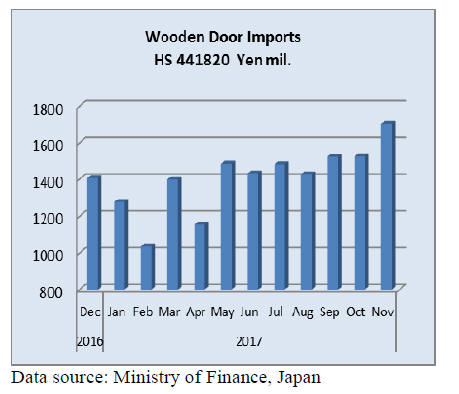
Windows
The value of wooden windows (HS441810) imports has
become more erratic over the past four months with
August 2017 imports dropping only to rise again in
September. However the expansion was not sustained
towards year end.
Infact, 2017 imports of wooden windows are likely to be
significantly below those of a year earlier based on data up
to November. Three shippers, China, US and the
Philippines each captures around a third of all Japan¡¯s
demand for imported wooden doors.
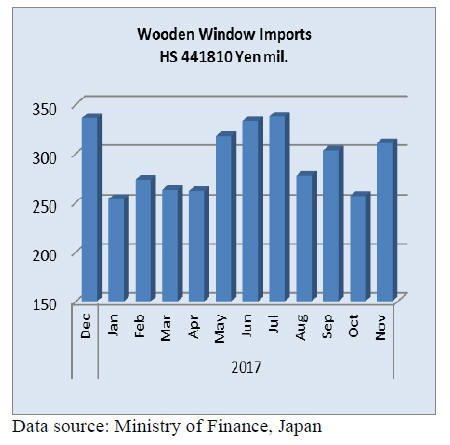
Assembled flooring
If Japan¡¯s imports of assembled wooden flooring
(HS441871-79) follow the usual pattern then there will be
a surge in December imports followed by a decline.
Year on year November assembled flooring imports were
up sharply (+17%) but compared to a month earlier import
values dropped.
Flooring falling within HS441875 accounted for the bulk
(70%) of November wooden flooring imports followed by
HS441879 at 25%. Imports of other categories of wooden
flooring are small. China was the only supplier of
HS441873, for HS441875 China was again the main
supplier (67%) followed by Indonesia (11%).
Shipments of HS441879 were fairly evenly distributed
between China, Thailand and Indonesia.
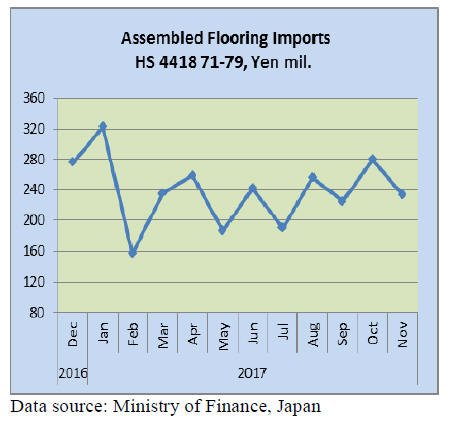
Plywood
Japan¡¯s November imports surged on the back of
increased shipments from Malaysia and Indonesia, both of
which were at monthly record highs.
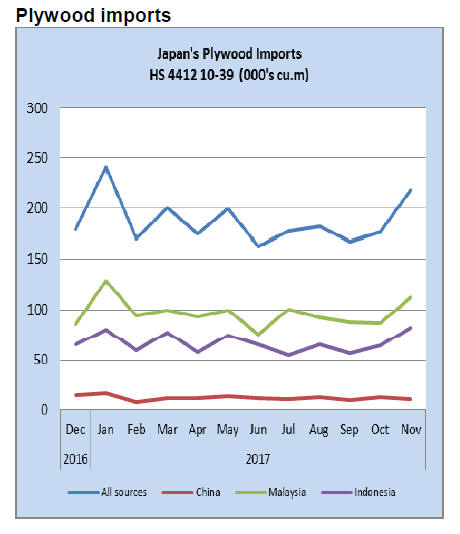
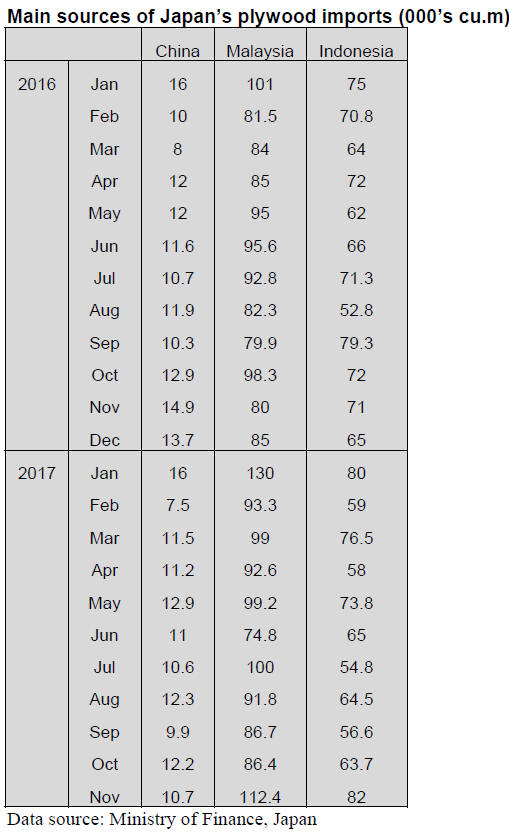
Since June last year Japan¡¯s plywood imports have
remained at around 170,000 cubic metres per month but
October and November shipments have risen lifting the
average monthly volume of shipments .
November shipments from Malaysia were mainly of HS
441231 with smaller volumes of HS 4412 33 and 34.
November shipments from Indonesia followed a similar
pattern with most being HS 441231 but more HS 441234
is shipped from Indonesia than Malaysia.
In contrast plywood shipments from China are of more
varied specifications with HS 441231 accounting for most.
Trade news from the Japan Lumber Reports (JLR)
The Japan Lumber Reports (JLR), a subscription trade
journal published every two weeks in English, is
generously allowing the ITTO Tropical Timber Market
Report to reproduce news on the Japanese market
precisely as it appears in the JLR.
For the JLR report please see:
http://www.nmokuzai.
com/modules/general/index.php?id=7
Japan¡¯s wood products exports climbing
There is increasing demand for Japanese wood products
from not only neighboring countries but far markets like
North America.
Logs and lumber have been exported to Korea, China and
Taiwan for last several years. The volume of lumber
export for the first ten months of 2017 was more than
107,000 cbms, more than 60% increase from 2016. About
60% is for China, 40% more than 2016. The volume for
the U.S.A. was more than 10,000 cbms, more than three
times of 2016. There was no export to the U.S.A. until
2013. Plywood export is also three times more than 2016.
Cedar lumber for the U.S. market is new demand after red
cedar supply gets short. It is mainly used for exterior like
fencing. Main size is 15 mm thick with length of 24 and
3.6 meters. There are increasing inquiries for this products.
Mukai Lumber in Ehime prefecture produces and ships
about 700-800 cbms of cedar lumber every month since
last summer. There are more sawmills handling this
product steadily now. Chugoku Lumber, the largest
Douglas fir lumber manufacturer, exported more than
10,000 cbms of cedar and cypress lumber for China, Korea
and Taiwan P.o.C in 2017, three times more than 2016 in
sales amount.
Presently monthly export volume is more than 10,000
cbms. Log export volume in 2017 did not quite reach one
million cbms but it is about 36% more than 2016.
Background of active export of Japanese wood is
worldwide climbing of wood prices and booming Chinese
economy. Log export prices from North America and New
Zealand are likely to go higher this year so there will be
more orders for Japanese cedar.
Wood products demand projection
The Forestry Agency held the meeting for wood products
demand projection for the first half of 2018. Imported
lumber from North America, Europe and structural
laminated lumber would decrease while logs from North
America for the second quarter and from New Zealand for
the first quarter would increase. Supply of domestic logs
for lumber would decrease some but logs for plywood
would increase by 8.5%.
Housing starts show sign of decline and average of 12
private think tanks forecast for 2017 is 960,000 units,
9,000 units less than previous forecast then forecast for
2018 is 961,000 units.
The Japan Federation of Housing Organization reported
that the survey made in last October through house
builders indicated that index of orders for the third quarter
2017 was minus 32 points and the amount was also minus
23 points. Orders were minus for six consecutive quarters.
North American lumber supply would continue in 2018
with climbing prices by active North American demand
while North American log demand remains firm and the
arrivals for the second quarter would be up by 7% but it
depends on winter weather on the Pacific coast.
European lumber, which supply increased in the fourth
quarter 2017, would decrease in the first quarter 2018 and
the purchase remains weak for the second quarter since the
market has no strength to pass on higher import cost.
Arrivals of structural laminated lumber for the first half of
2018 would decline by 11.5% while domestic production
of structural laminated lumber would remain the same as
2017.
Demand for domestic plywood would continue active for
the first half of 2018. The supply would increase as a new
plywood mill would start up in April 2018. This would
result in higher demand of domestic logs for plywood
manufacturing in 2018.
Meantime, there are different views on demand for
domestic lumber. Some forecast the same degree of
demand of the first half while the others comment slight
decline of demand.
Plywood
Supply tightness continues on both domestic and imported
plywood. Active demand for domestic softwood plywood
continues after the New Year by precutting plants.
Inventories of imported thin panel, floor base and coated
2x6 concrete forming are down. This seems to continue
until March.
November plywood production in 2017 was 271,200
cbms, 8.1% more than November 2016 and 1.3% more
than October, which was the highest monthly production.
In this, softwood plywood was 257,600 cbms, 6.5% more
and 1.5% more.
The shipment of softwood plywood was 268,500 cbms,
6.5% more and 1.7% less. Since the production was more
than the shipment, the inventories were 102,900 cbms,
2,300 cbms increase.
Usually December is busy month for distribution so many
failed to deliver even with produced plywood due to
shortage of trucks. Many construction works are carried
over into January so busy demand would continue through
January.
Arrivals of imported plywood was 279,000 cbms, 20.3%
more and 20.5% more. Malaysian supply was 115,600
cbms, 39.0% more and 31.9% more.
Indonesian supply was 91,100 cbms, 15.1% more and
25.4% more. Chinese supply was 57,900 cbms, 6.8% more
and 5.8% more. Despite supply increase in November, the
supply from South East Asian countries would be down in
December because of arrival of rainy season.
The movement of imported plywood in Japan continues
inactive but the demand should pick up in 2018 for various
constructions related to the Tokyo Olympic Games in
2020 and start of urban redevelopment and if the supply
declines when the demand recovers, some fear delay of
construction activities.

South Sea (tropical) logs
South East Asian countries are in rainy season now so log
production is low.
Japanese plywood manufacturers have been struggling to
secure material logs since last fall and some bought
mersawa to supplement meranti. Present market prices of
Sarawak meranti regular are 12,000 yen plus per cbm CIF
and further increase is expected.
Domestic inventories of keruing and melapi for lumber
manufacturing are down. Lumber manufacturers
commented that they may need to consider using genban
instead of logs.
Movement of laminated free board from China and South
East Asia continues slow. The inventories are low but
demand and supply are balanced. Market prices of
Indonesian mercusii pine are high end of level of 110,000
yen per cbm FOB truck and Chinese red pine are middle
of 110,000 yen level.
Inventory of solid lumber of keruing and white serayah
used for truck body and ship building is very low.
Russia to increase log export duty
The Russian government announced a new ministerial
ordinance regarding log export from the Far East regions.
It states that if any company, which achieved a certain
amount of wood processing, wishes to export logs, 6.5%
export duty rate is applied then the duty will be increased
step by step and the rate will be 80% after 2021, which
practically prohibits log export.
The idea is to promote wood processing in the Far East
regions. The ordinance is effective since January 1, 2018.
While promoting processing wood, the government allows
export of logs unsuitable for processing and the annual
quota of log export is four million cubic meters.
Applicable species are whitewood and larch.
Any company, which has amount of share of 20% of all
export processed products, is allowed 6.5% export duty
then processed percentage is raised year after year like
25% in 2019 and 35% after 2021. Processed products
mean lumber, veneer, plywood and wood chip.
Log export duty rate is raised step by step. 25% in 2018,
40% in 2019, 60% in 2020 and 80% after 2021. China
buys sizable volume of Russian logs and if this is strictly
applied, China will need to look for log sources elsewhere
and the most likely sources would be North America and
New Zealand.
|